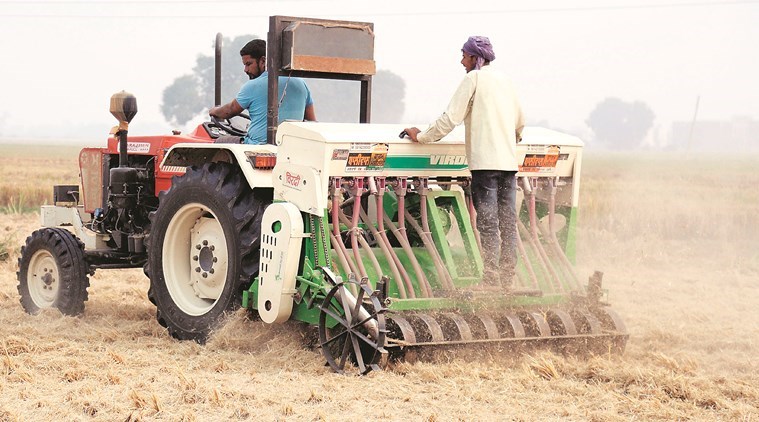 Due to continuous bad weather conditions in December and January in this rabi crop sowing season, PRCS was not getting the exact picture of area sown through Happy Seeders.
Due to continuous bad weather conditions in December and January in this rabi crop sowing season, PRCS was not getting the exact picture of area sown through Happy Seeders.
Despite increasing the number of Happy Seeders from 9,000 last year to 16,000 this year, a fall of around 48,000 acres area under wheat cultivation using these machines has been recorded, according to satellite data analysed and released by Punjab Remote Sensing Centre (PRSC). The data shows a fall in acreage in 12 out of 22 districts of the state.
Due to continuous bad weather conditions in December and January in this rabi crop sowing season, PRCS was not getting the exact picture of area sown through Happy Seeders.
The data sourced from the PRSC, Punjab Agriculture University (PAU), Ludhiana, revealed that this year Happy Seeder sown wheat area was 5.30 lakh hectares (13.09 lakh acres) out of the total wheat area of 35.05 lakh hectares (86.82 lakh acres) in Punjab.
Last year, the area under Happy Seeder sowing was 5,49,370 (13.57 lakh acres), out of the total 34.90 lakh hectares (86.20 lakh acres).
Data showed that out of 22 districts of Punjab, 12 districts have shown a downward trend of sowing with Happy Seeders this year, while 10 districts have shown marginal to fair increase in the the sowing area.
The districts which have recorded a downward trend include Amritsar, where 31,240 hectares, which is 16.6 per cent of total 1,88,000 hectares wheat area, was sown with Happy Seeder against against 38,620 hectares last year. Amritsar saw a decrease of 7,380 hectares under Happy Seeder sowing area. In Bathinda, 31,150 hectares, which is 12.2 per cent of the total 2,54,000 hectares of wheat area, was sown against 43,000 hectares last year. Bathinda saw a decrease of 9,000 hectares (22,230 acres). Kapurthala district recorded 20,630 hectares, which is 22 per cent of total 1,09,000 hectares wheat area, against 28,040 hectares last year and saw a decrease of 26.5 per cent area under Happy Seeder with a fall of around 7410 hectares (18,302 acres).
SBS Nagar recorded 17,520 hectares under Happy Seeder sowing which is 23 per cent of the total 76,000 hectares of wheat area and around 2,000 hectares less than the last year.
In Mansa, 33,520 hectares, which 19.7 per cent of total 1,70,000 hectares of wheat area, was recorded against 36,940 hectares last year that comes out to a decrease of 3, 420 hectares (8,447 acres). Pathankot, which saw minimum stubble burning area (4630 hectares) in state, also witnessed a decrease of 3,000 hectares (7400 acres) under Happy Seeder sowing this year. Apart from this Rupnagar, Gurdaspur, Mukatsar, Ludhiana, Jalandhar and Ferozepur districts have also recorded a downward trend.
The districts which have shown a fair increase in the area have Patiala on the top with an increase of around 6,000 hectares (14,820 acres), Tarn Taran, which saw an increase of 3000 hectares, Barnala, which saw an increase of 2870 hectares. Faridkot recorded an increase of around 2,550 hectares, Fatehgarh Sahib saw an increase of 2,200 hectares. Apart from these, Hoshiarpur, Mohali, Fazilka, Moga and Sangrur also saw an increase. In Sangrur, 54,410 hectares, which is 18.7 per cent of the total 2,90,000 hectares of wheat area, recorded against 52,500 hectares of last year.
“The acreage recorded through satellite shows the exact picture because the details collected from the district agriculture offices were not as correct and it was calculated at 4.50 lakh hectares with Happy Seeder sowing,” said a senior officer in the Agriculture department.
“We could calculate this data quite late this year because of the cloudy weather coupled with rains in December and January months due to which area could be recorded time to time and then it was calculated recently,” said Dr Anil Sood, head of the ACM Division, PRSC, Ludhiana a senior officer in the PRCS centre.
General secretary of BKU Dakaunda, Jagmohan Singh, said Happy Seeder had not given good results to several farmers last year and so they opted for the traditional method of sowing this year. He said the government should give compensation to farmers to manage stubble instead of bringing in huge machinery.
Happy Seeder machine is the most publicised among machines which sow wheat directly after paddy harvesting without burning stubble.
“Farmers have preferred other methods of direct wheat sowing rather than Happy Seeder this time,” said senior officer in the Agriculture Department.